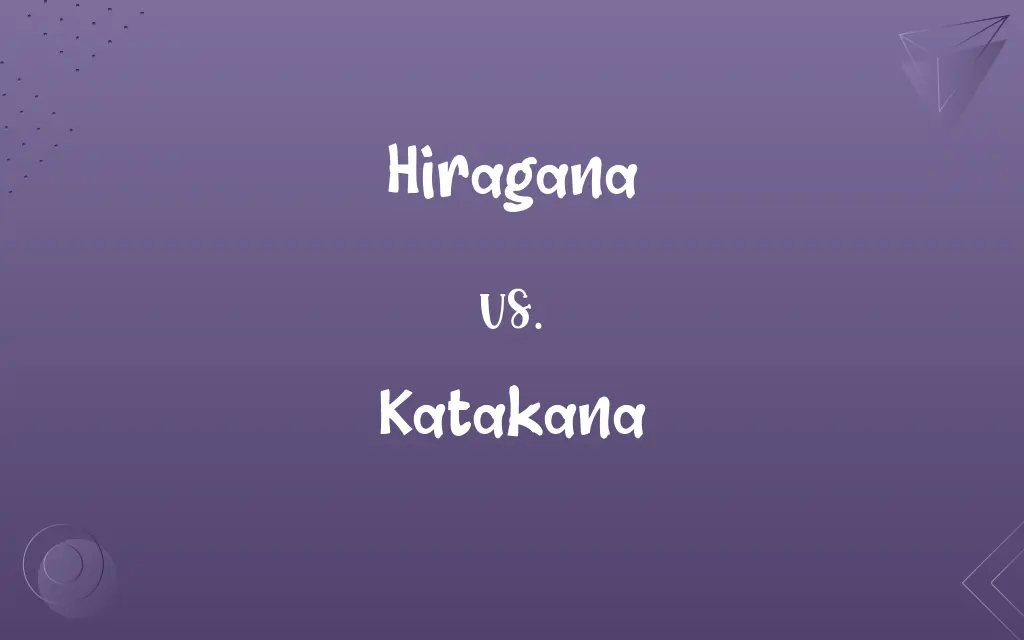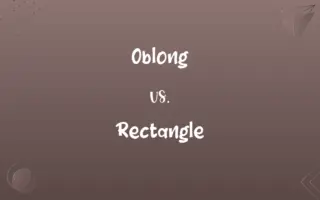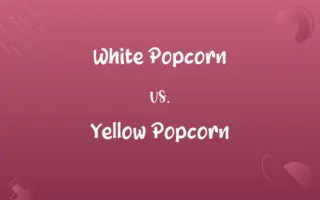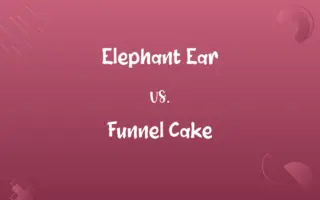Hiragana vs. Katakana: Know the Difference

By Shumaila Saeed || Published on February 28, 2024
Hiragana and Katakana are both Japanese syllabaries; Hiragana is used for native words and grammatical elements, while Katakana is primarily used for foreign words and names, onomatopoeia, and scientific names.

Key Differences
Hiragana and Katakana are integral parts of the Japanese writing system. While Hiragana is often used for native Japanese words and grammatical functions, Katakana is employed for foreign loanwords, technical and scientific terms, and names of plants, animals, and minerals.
Shumaila Saeed
Feb 28, 2024
Hiragana characters are curvy and flowing, reflecting their historical development from cursive script, and are used to write inflectional endings and particles in Japanese. In contrast, Katakana characters are more angular and straightforward, developed from parts of kanji characters, and are used for transcription of foreign words and onomatopoeia.
Shumaila Saeed
Feb 28, 2024
The role of Hiragana in Japanese texts is to make reading and understanding native words and grammatical structures easier. Katakana, on the other hand, is used to distinguish foreign words and concepts within a Japanese text, giving them a distinct appearance.
Shumaila Saeed
Feb 28, 2024
Learning Hiragana is typically the first step for beginners in Japanese, as it provides the foundation for reading and writing most Japanese words and sentences. Katakana, while also fundamental, is usually learned after Hiragana, as it deals more with non-native elements of the language.
Shumaila Saeed
Feb 28, 2024
In modern Japanese, both Hiragana and Katakana are indispensable. Hiragana is used extensively in literature, media, and official documents for native Japanese words, while Katakana is seen in contexts like advertising, imported product names, and media to highlight foreign or modern influences.
Shumaila Saeed
Feb 28, 2024
ADVERTISEMENT
Comparison Chart
Origin
Developed from cursive script
Developed from parts of kanji characters
Shumaila Saeed
Feb 28, 2024
Role in Japanese Texts
For reading native words and grammar
Distinguishing foreign words and concepts
Shumaila Saeed
Feb 28, 2024
ADVERTISEMENT
Hiragana and Katakana Definitions
Hiragana
Hiragana is the more commonly used kana in Japanese writing.
たべる (taberu) means to eat in Hiragana.
Shumaila Saeed
Jan 19, 2024
Katakana
Katakana is a Japanese syllabary primarily used for foreign words and names.
アメリカ (Amerika) means America in Katakana.
Shumaila Saeed
Jan 19, 2024
Hiragana
Hiragana serves as phonetic markers in Japanese text.
ねこ (neko) means cat in Hiragana.
Shumaila Saeed
Jan 19, 2024
Katakana
Katakana characters are more angular and used for emphasis and technical terms.
コンピュータ (Konpyūta) means computer in Katakana.
Shumaila Saeed
Jan 19, 2024
Hiragana
Hiragana is a Japanese syllabary used for native words and grammatical elements.
あめ (ame) means rain in Hiragana.
Shumaila Saeed
Jan 19, 2024
ADVERTISEMENT
Katakana
Katakana is used for transcription of foreign language words into Japanese.
ピザ (Piza) means pizza in Katakana.
Shumaila Saeed
Jan 19, 2024
Hiragana
Hiragana characters are derived from cursive forms of kanji.
かわいい (kawaii) means cute in Hiragana.
Shumaila Saeed
Jan 19, 2024
Katakana
Katakana is also used for onomatopoeia and mimetic words in Japanese.
ワンワン (Wanwan) represents the sound bark in Katakana.
Shumaila Saeed
Jan 19, 2024
Hiragana
Hiragana is essential for conjugating verbs and adjectives in Japanese.
はしる (hashiru) means to run in Hiragana.
Shumaila Saeed
Jan 19, 2024
Katakana
Katakana appears in specialized contexts like scientific names and advertising.
タイヤ (Taiya) means tire in Katakana.
Shumaila Saeed
Jan 19, 2024
Hiragana
The cursive and flowing variety of kana used in most modern Japanese texts especially to represent inflectional endings and particles.
Shumaila Saeed
Jan 18, 2024
Katakana
A relatively angular kana used especially to write foreign words, onomatopoetic words, and the names of plants and animals in Japanese.
Shumaila Saeed
Jan 18, 2024
Hiragana
(uncountable) The main syllabary for the Japanese language, used to represent native Japanese words, including particles, and when kanji is used, to represent verb and adjective endings.
Shumaila Saeed
Jan 18, 2024
Katakana
(uncountable) A Japanese syllabary used when writing words borrowed from foreign languages other than Chinese, specific names of plants and animals and other jargon, onomatopoeia, or to emphasize a word or phrase. Also used to write the Ainu language.
Shumaila Saeed
Jan 18, 2024
Repeatedly Asked Queries
How many characters are there in Hiragana?
There are 46 basic Hiragana characters.
Shumaila Saeed
Feb 28, 2024
What is Katakana?
Katakana is a syllabary used in Japanese for foreign words, names, and scientific terms.
Shumaila Saeed
Feb 28, 2024
Are Hiragana and Katakana interchangeable?
No, they serve different purposes in Japanese writing.
Shumaila Saeed
Feb 28, 2024
What is Hiragana?
Hiragana is a syllabary used in Japanese writing for native words and grammatical elements.
Shumaila Saeed
Feb 28, 2024
How many characters are in Katakana?
Katakana also has 46 basic characters.
Shumaila Saeed
Feb 28, 2024
Can a word be written in both Hiragana and Katakana?
Yes, but the choice depends on context and meaning.
Shumaila Saeed
Feb 28, 2024
Why is Katakana used for foreign words?
To distinguish them from native Japanese words in text.
Shumaila Saeed
Feb 28, 2024
Can Hiragana and Katakana be mixed in a sentence?
Yes, it's common in Japanese writing.
Shumaila Saeed
Feb 28, 2024
What is the historical origin of Hiragana?
It evolved from cursive forms of kanji characters.
Shumaila Saeed
Feb 28, 2024
Why is Hiragana important in Japanese?
It's essential for reading and writing native Japanese words and grammar.
Shumaila Saeed
Feb 28, 2024
Is it necessary to learn both Hiragana and Katakana?
Yes, for proficiency in reading and writing Japanese.
Shumaila Saeed
Feb 28, 2024
What is the historical origin of Katakana?
It was developed from parts of kanji characters.
Shumaila Saeed
Feb 28, 2024
Is handwriting important for Hiragana and Katakana?
Yes, especially in formal and educational settings.
Shumaila Saeed
Feb 28, 2024
Do Japanese children learn Hiragana or Katakana first?
They usually learn Hiragana first.
Shumaila Saeed
Feb 28, 2024
Are there any silent characters in Hiragana or Katakana?
No, each character represents a specific sound.
Shumaila Saeed
Feb 28, 2024
How is Katakana used in Japanese media?
For foreign words, technical terms, and emphasis.
Shumaila Saeed
Feb 28, 2024
How is Hiragana used in Japanese literature?
For writing prose, poetry, and grammatical conjugations.
Shumaila Saeed
Feb 28, 2024
Are there combined forms in Hiragana and Katakana?
Yes, both have combined forms for certain sounds.
Shumaila Saeed
Feb 28, 2024
Can Hiragana and Katakana be computerized?
Yes, both are fully compatible with digital formats.
Shumaila Saeed
Feb 28, 2024
How do pronunciation rules differ for Hiragana and Katakana?
Pronunciation is generally the same, but context affects intonation.
Shumaila Saeed
Feb 28, 2024
Share this page
Link for your blog / website
HTML
Link to share via messenger
About Author
Written by
Shumaila SaeedShumaila Saeed, an expert content creator with 6 years of experience, specializes in distilling complex topics into easily digestible comparisons, shining a light on the nuances that both inform and educate readers with clarity and accuracy.




































































